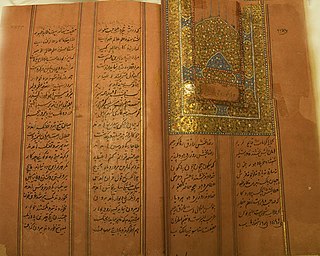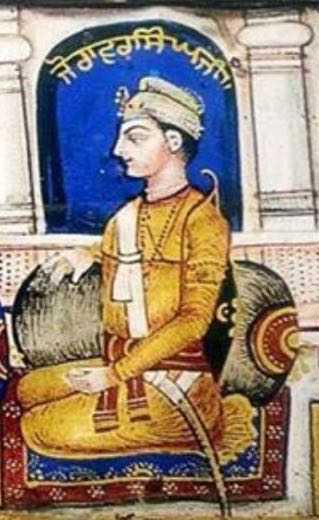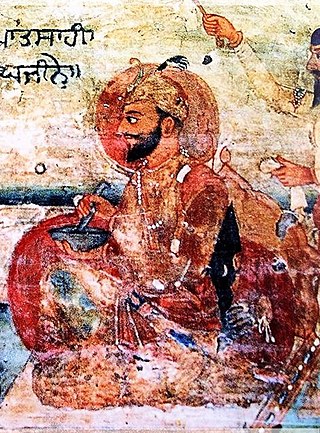
Guru Gobind Singh was the tenth and last human Sikh Guru. He was a warrior, poet, and philosopher. In 1675, at the age of nine he was formally installed as the leader of the Sikhs after his father Guru Tegh Bahadur was executed by Emperor Aurangzeb. His father was the ninth Sikh Guru. His four biological sons died during his lifetime – two in battle and two executed by the Mughal governor Wazir Khan.

The term Khalsa refers to both a community that follows Sikhism as its religion, as well as a special group of initiated Sikhs. The Khalsa tradition was initiated in 1699 by the Tenth Guru of Sikhism, Guru Gobind Singh. Its formation was a key event in the history of Sikhism. The founding of Khalsa is celebrated by Sikhs during the festival of Vaisakhi.

The Zafarnāma was a spiritual victory letter sent by Guru Gobind Singh in 1705 to the Mughal Emperor of India, Aurangzeb, after the Battle of Chamkaur.

Bhagat Dhanna, also known Dhanna Jat, Dhanna Jatt, Dhanna Bairagi or Sant Dhanna, was a mystic poet and a Vaishnav devotee whose three hymns are present in Guru Granth Sahib.

Panj Pyare refers to a gathered ad hoc quintet of five baptised (Amritdhari) Khalsa Sikhs who act as institutionalized leaders for the wider Sikh community.
Mohkam Singh, born Mohkam Chand, was one of the inaugural group of Panj Pyare, or the first Five Beloved of honoured memory in the Sikh tradition.
Daya Singh was one of the Panj Pyare, the first five Sikhs to be initiated into the Khalsa order in 17th-century India. Among the inaugural panj piare quintet, he is traditionally the highest-regarded as he was the first to answer the call for a sacrifice from the guru. Daya Singh was an educated Sikh, with literature being attributed to his authorship.
Bhai Himmat Singh (1661–1705), born Himmat Rai, was one of the inaugural group of Panj Pyare, or the first group of the Five Beloved in Sikhism.
Sahib Singh was one of the Panj Pyare. He was formerly known as Sahib Chand and was born into the Nai caste before being baptized into the Khalsa tradition.

The Tat Khalsa, also romanised as Tatt Khalsa, known as the Akal Purkhias during the 18th century, was a Sikh faction that arose from the schism following the passing of Guru Gobind Singh in 1708, led by his widow Mata Sundari, opposed to the religious innovations of Banda Singh Bahadur and his followers. The roots of the Tat Khalsa lies in the official formalization and sanctification of the Khalsa order by the tenth Guru in 1699.

Zorawar Singh, alternatively spelt as Jorawar Singh, was a son of Guru Gobind Singh who was executed in the court of Wazir Khan, the Mughal Governor of Sirhind.
Rehat refers to the rules and traditions which govern the unique Sikh lifestyle and determines correct Sikh orthodoxy and orthopraxy. The Sikh Rehit Maryada is a code of conduct and conventions for Sikhism. The final version of the Rehat Maryada was controversially approved by the Shiromani Gurdwara Parbandhak Committee, Amritsar in 1945. The Rehat Maryada was created to provide guidance to Sikhs on practical and functional aspects of daily life, including the operations of Sikh Gurdwaras, and religious practices to foster cohesion throughout the community. Rehitnāma is a Punjabi term that refers to a genre of Sikh religious literature which expounds upon specifying an approved way of life for a Sikh.

Mai Bhago also known as Mata Bhag Kaur, was a Sikh woman who led Sikh soldiers against the Mughals in 1705. She was an exceptionally skilled warrior on the battlefield and is revered as a warrior saint in Sikhism. She was known for rallying the 40 Sikhs who abandoned Guru Gobind Singh at the siege of Anandpur Sahib and bringing them back to fight.

The Battle of Chamkaur, also known as Battle of Chamkaur Sahib or the Second battle of Chamkaur, was fought between the Khalsa, led by Guru Gobind Singh, and the coalition forces of the Mughals led by Wazir Khan and Hindu hill chiefs. Guru Gobind Singh makes a reference to this battle in his letter Zafarnama.
Martyrdom is a fundamental institution of Sikhism. Sikh festivals are largely focused on the lives of the Sikh gurus and Sikh martyrs. Their martyrdoms are regarded as instructional ideals for Sikhs, and have greatly influenced Sikh culture and practices.

Amrit Sanskar is one of the four Sikh Sanskaars. The Amrit Sanskar is the initiation rite introduced by Guru Gobind Singh when he founded the Khalsa in 1699.

Binod Singh, a Trehan Khatri and a descendant of Guru Angad, was an army man and disciple of Guru Gobind Singh and was among few Sikhs who accompanied him to Nanded in 1706. In Budha Dal Chronicles, Guru Gobind Singh made Baba Binod Singh the head of the Khalsa.
Bhai Sangat Singh was a Sikh warrior and martyr of Battle of Chamkaur.

Kavi Darbar is a term that refers to historical Sikh durbars (courts) composed of congregations of poets, litterateurs, artists, and scholars that were established and had flourished during the guruship period of Guru Gobind Singh in the late 17th and early 18th centuries. These establishments served as Sikh centres of learning and scholarship. They played a pivotal role in the history of Sikh literature.












